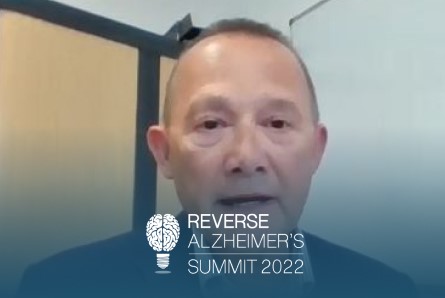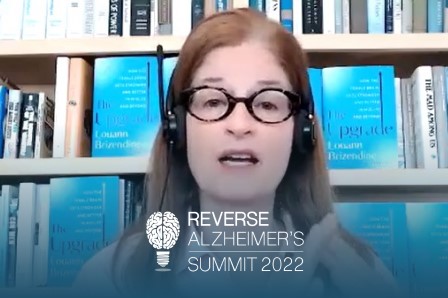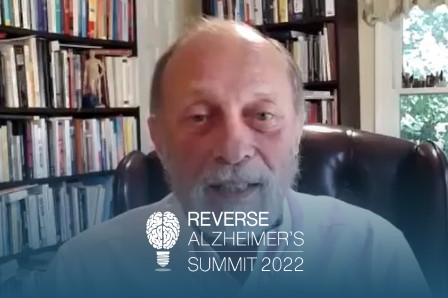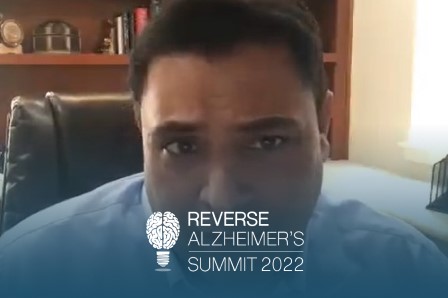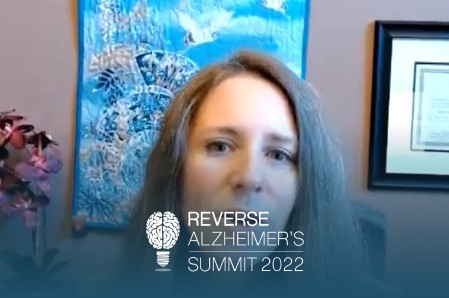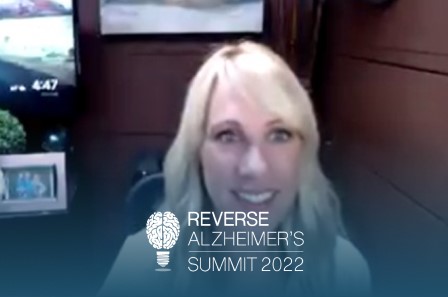Join the discussion below

Dr. Heather Sandison is the founder of Solcere Health Clinic and Marama, the first residential care facility for the elderly of its kind. At Solcere, Dr. Sandison and her team of doctors and health coaches focus primarily on supporting patients looking to optimize cognitive function, prevent mental decline, and reverse... Read More

Dr Richard Pither, CEO, Cytox Ltd: At Cytox, Richard has spent 25 years in the Alzheimer's disease field and is focused on developing novel genetic tests for assessing Alzheimer’s Disease risk. The genoSCORE test, developed in partnership with Thermo Fisher Scientific and Sampled, is aimed at clinicians assessing patients at... Read More
This speaker presentation features Heather Sandison, ND, and Dr. Richard Pither discussing a new test that can help practitioners identify patients at risk of cognitive decline, specifically those at risk of developing Alzheimer’s disease. The test uses genetic mapping to produce a polygenic risk score, categorizing individuals into risk groups. It is less invasive and expensive than other techniques and is readily available to everyone.
Cytox launched their test, “The Alzheimer’s Risk Test – powered by genoSCORE,” in North America in late 2021, led by their testing laboratory partner, Sampled – The Alzheimer’s Risk Test is a Polygenic Risk Scoring (PRS) test that provides a comprehensive assessment of genetic risk linked to late-onset Alzheimer’s disease and associated cognitive decline. Alzheimer’s disease is a highly complex disease with risk factors based on genetics, lifestyle, age, and environment, but up to 50% of the risk factors are modifiable and so can be addressed to reduce overall risk.
The Alzheimer’s Risk Test is offered by approved clinical practices and requires only a simple saliva sample; it uses a Polygenic Risk algorithm to predict the risk of individuals developing Alzheimer’s disease and optimize clinical management of those at the highest risk. While the test is not a diagnostic tool, it can provide individuals with valuable information to take proactive measures to mitigate their overall risk. This test is specifically designed to identify individuals at risk of Alzheimer’s disease and falls into two categories: symptomatic individuals and younger individuals with a family history of cognitive decline.
It is essential to seek professional clinical support before taking the test as genetic input, environmental factors, and comorbidities all contribute to overall Alzheimer’s risk.
Takeaways:
- A groundbreaking test can identify individuals at risk of Alzheimer’s disease and cognitive decline.
- The test is conducted through a genetic mapping exercise, producing a single number describing an individual’s genetic risk.
- The test is readily available to everyone and requires either a saliva collection kit or a blood sample, and it is less invasive and far less expensive than other techniques.
- While knowing one’s Alzheimer’s risk can be significant, it is essential to remember that genetic input, environmental factors, and comorbidities contribute to overall Alzheimer’s risk.
- Patients should discuss the test with their clinician to determine whether it suits them and seek professional clinical support before taking it. A proactive approach to managing lifestyle and environmental risks is crucial for everyone.
Heather Sandison, N.D.
Welcome back to the Reverse Alzheimer’s Summit. I’m your host, Dr. Heather Sandison, and I’m delighted to introduce you to Dr. Richard Pither. He’s the CEO of Cytox. At Cytox, Richard has spent 25 years in the Alzheimer’s disease field and is focused on developing novel genetic tests for assessing Alzheimer’s disease risk. The genoSCORE test, developed in partnership with Thermo Fisher Scientific and Sampled, is aimed at clinicians assessing patients at risk of cognitive decline due to Alzheimer’s disease, in addition to pharma companies seeking high-risk patients for recruitment into clinical trials. Over the past 25 years, Richard has developed diagnostic and therapeutic products for GE, UCB, Caltech, Laurantis, and Amersham. Richard’s academic training is from Bristol University in the UK and Harvard Medical School. Richard, thanks so much for taking the time to join us.
Dr. Richard Pither
Pleasure, thank you.
Heather Sandison, N.D.
So I learned about your test recently when I was at a conference, and I was so excited that we could put a number to this idea of risk, like how likely. I can’t tell you how many children bring in their parent who’s already suffering, and they’re sitting there wondering, well what about me? We have the same genetics, or at least I’ve got half of her genetics or his genetics, how worried do I need to be about this and should I get started on the program? And so having a number to associate with that question as an answer is so valuable for people. Can you tell us a little bit about how you arrived at creating this risk number?
Dr. Richard Pither
Sure. I mean, the motivation here, Heather, is very much around exactly finding these patients at the earliest possible juncture when the chances to intervene are likely to be far more efficacious. And so those patients, really as you describe there, fall into two groups. You have the symptomatic individual who may themselves realize they have a problem, or it may be that they’ve been referred to by a loved one or a family member. Or indeed a younger individual who has been aware of a parent or a grandparent that’s been diagnosed previously and wants to know, as you said, whether they’ve inherited this risk. So, what we do is we look, and what we’ve developed here is the most comprehensive description of genetic risk for late-onset Alzheimer’s disease, so the common form of Alzheimer’s disease, typically manifesting in people of 65 years and above, but can actually appear a little bit earlier sometimes. The way this works is that there’s been a genetic mapping exercise that’s gone on for the last 10 years really through a big consortium called the International Genomics of Alzheimer’s Program. And what we’ve been doing is collecting data from very large numbers of age-matched people, some of whom have Alzheimer’s and some of whom don’t, and then doing effectively a piece of detective work to pick out those genetic elements that seem to link to increased Alzheimer risk. Now, working through that data with academic collaborators and partners in the UK, we’ve identified about 112,000 different DNA variants, all of which we carry to some extent, which confer a little bit of added risk or a little bit of reduced risk. And what we’ve basically built is an algorithm that detects those variants and then adds them up in a weighted formula to come up with a single number which describes genetic risk. We then combine age and gender to come up with what we call the polygenic risk score or genoSCORE that you mentioned. So one being the highest risk, zero being the lowest risk, and we can then essentially put people into different risk categories like that.
Heather Sandison, N.D.
So most of our listeners are familiar with the APOE genetic, and this is, I know, something that you’re testing. How is your test different from just knowing your APOE status?
Dr. Richard Pither
Okay, so APOE is a very important gene. We all carry the APOE gene and it comes in various different forms. And some of your listeners may know that if you inherit, and you can buy a test today from 23andMe and find out whether you carry one or two copies of the e4 version of APOE. And if you do, there’s no doubt you are at increased risk of Alzheimer’s disease, it’s a key genetic contributor. But the problem is that you can carry e4 and still never develop Alzheimer’s disease. Conversely, about 40% of people that develop Alzheimer’s disease do not have e4 alone, so it’s not a good descriptor of Alzheimer’s genetic risk. What we do is incorporate e4 as one of the 112,000 different elements that we combine together to give a far more accurate and descriptive genetic risk profile for the risk of developing late-onset Alzheimer’s disease. And we can look at that, we’ve published data in peer-reviewed scientific journals which shows how much better we are at picking out high-risk individuals with e4 or indeed high-risk individuals without e4. So we can differentiate to a far greater extent.
Heather Sandison, N.D.
So I wanna just break down some of these numbers so that people can have a tangible kind of sense of what’s going on here. So if you have APOE 4/4, you have, and please correct me, ’cause you are the expert in this and I’m just a clinician over here, so if you have e4/4, 4 from mom, 4 from dad, then you have about a one in two chance, a 50% chance of developing dementia over the course of your life. If you have a 3/4, say just one copy, so one from mom or dad and then you don’t have a 4 from mom or dad, you have a 3 or a 2, I don’t think I’ve ever seen a 2/4, but a 3/4 is pretty common, then you have a one in three-ish chance of developing dementia. The population at large has about a 13% chance of developing dementia. So these are significantly elevated risks. If you do not have a 4, then my understanding is you have about a 9% risk, so a little less than the general population. So about a one in 10 risk. Now what you’re describing is creating a number that is even more specific to that. So how do we know if you have a 4/4, are you in the camp, the 50% that gets dementia, or the camp that’s the 50% that doesn’t? And we know, of course we’ve been talking a lot on this summit about all of the lifestyle factors that influence this, however, these genetic factors and understanding them, if we know that we actually have an 80% risk or a 90% risk genetically of developing dementia, then we know we wanna work that much harder, that much earlier in our life to prevent this. Am I understanding all of this right?
Dr. Richard Pither
Absolutely. I mean, whatever test you’re using, if it puts you into high-risk category, you need to remember that it’s not a diagnostic test, okay? So it is not predetermined that someone with a high polygenic risk or even a low polygenic risk will or will not develop Alzheimer’s disease. You correctly mentioned that it’s a combination really of genetic input, but also lots of environmental and comorbidities that contribute to overall Alzheimer risk. The point is if you test early and you find you’re at high genetic risk, then the rewards for taking on management, proactive management of those other lifestyle, environmental risks are that much greater in terms of mitigating your overall risk, either the time at which you might develop Alzheimer’s disease or indeed the rate at which your decline associated with Alzheimer’s disease might occur. So, let’s go back to the APOE story. So, if you think about the Caucasian population, these genetics get quite complicated quite quickly, because depending on ethnic backgrounds the influence can be a bit different. But typically in a Caucasian population, about 25% of the population carry one or more copies of the APOE4 allele, or form of APOE, and 75% of people carry none.
So let’s take that 75% group. So if you’re in that 75% group, you think you might be feeling quite smug, I’m very low-risk genetically, but we know about 40% of Alzheimer’s disease comes from that group. So in the absence of an e4 risk, how do you assess genetic risk? Well, our test is able to identify people that don’t carry e4 that have very much an e4-like risk. We can stratify in a sort of distribution those at the high end of that curve. So we can pick out, with clinicians, those at highest risk who will benefit more from those sort of lifestyle and interventions and treatments of comorbidities. And conversely, we can pick out people that do carry e4 who are still at relatively lower genetic risk overall, because their e4 risk is mitigated by some of the other genetic elements that they may have inherited from one parent or the other. So what we’re describing here is a far more comprehensive look at the genetic landscape in any individual and how that will contribute to a lifetime genetic risk.
Heather Sandison, N.D.
Got it. So if someone already is symptomatic, I see a lot of patients in their 70s and 80s who are suffering, their children, adult children usually bring them in or a dear friend or caregiver, and is there a reason for them to get this test? If they already have symptoms, might they wanna inform anyone genetically related to them, or what what’s the utility for someone in that category?
Dr. Richard Pither
So you may be aware of this publication that came out in 2020, Heather. There was a Lancet Commission that basically put together a meta-analysis of all the data associated with the impact of these lifestyle and comorbidity treatments, and they concluded that something like up to 50% of the risk for Alzheimer’s disease was modifiable. Now that’s a huge amount. Even in a high genetic risk individual, that’s definitely a prize worth going for, right? But the most important thing I think they published in addition to that was that even in people with early symptoms, taking those lifestyle modification steps even at that point in the symptomatic phase of the disease still had very manageable and measurable benefit to the patient, so a suggestion that you can actually reverse some of these early symptoms, which is really exciting. And perhaps that’s your experience in your own clinic, which I know you’ve spoken very eloquently about in the past. So I think that that’s a really important thing to bear in mind. A lot of this work from the Lancet Commission, which was taking the top clinical experts and scientists from across the world, US, Europe, and other places as well, and was a consensus document with a huge number of authors, I think really went under the radar a little bit because of the COVID pandemic and the unfortunate timing when it came out.
So a lot of clinicians, even specialist clinicians, have missed this, and we need to go back and educate them and patients about the benefits of this work, much of which stems back from the so-called FINGER studies that Professor Miia Kivipelto from Finland, now based in Sweden, actually set out and managed over a number of years, these long-term observational studies which identified some of these factors that can be modified to change risk. So that’s really, really important, that’s something that’s available to everyone today. Also, of course, on the radar now is the possibility of disease-modifying therapeutics becoming available. We know about the Biogen story, the FDA approval, but as yet the lack of reimbursement in the Biogen drug, but there are other Biogen-like drugs coming through. Just last week, Eisai actually submitted their file, their dossier with the FDA for review. We know that Eli Lilly, we know that Roche and other companies also have similar drugs coming through their pipeline. So, as well as these lifestyle modifications, genuine disease-modifying drug therapies are maybe not too far away, we all hope. So that’s yet another reason to want to understand risk, I think.
Heather Sandison, N.D.
Yeah, there’s this refrain from the conventional community, at least as I see it, that there’s nothing you can do, and so why would you want to know your risk? It will just stress you out, create a new problem. If I’m a neurologist and I’ve got Namenda and Aricept and those are my options and really my message is to get your affairs in order because this is just a downhill slope, then to understand risk really makes my job a lot harder, right? So I’m not gonna offer this test to people. And yet what we’re seeing in well-respected journals like “The Lancet” is that there is so much that we can do. And certainly I would sort of push back that we don’t have to wait for drugs like aducanumab to be available, and that really I think we’ll get even better outcomes by addressing these modifiable risk factors, getting rid of whatever’s causing the inflammation, the plaques and tangle formation. And that ideally what we’ll do in the future is as those drugs become available that reduce plaques and tangles, that kind of scar tissue of inflammation in the brain, is that we’ll do all of our work first to get rid of the why from the inflammation and then we’ll add those medications just temporarily to kind of clean up that scar tissue and create space for neurogenesis and neuroplasticity that can help patients achieve, dare I say, a cure, or something at least going in that direction. So I’m wondering, do you see it kind of playing out similarly?
Dr. Richard Pither
I absolutely do, and I think we are not alone in believing this. The advent of the brain health clinic, which is really targeting people who today have no disease, they have no symptoms, but they need to raise awareness about what they may be in for in the future and then start managing that outcome at the early presymptomatic stages. It’s much easier to preserve or reduce the rate of decline of neuronal loss than it is to replace. And so anything we can do to help that, I mean, you’ll know as well as the sort of various dietary and lifestyle interventions, just sort of social and physical activity can have a huge impact, the lack of isolation. Treatment for hearing loss has been shown to have benefits as well, otherwise, they’re lacking a lot of natural stimuli and it sort of forces them to interact less, which is not a good thing. So all these things have very material benefit, and there are I think a greater number of clinics and clinicians now recognizing this, but there’s still a lot of work to be done on educating people. I was at the World Dementia Council meeting in London about a month ago, and when some of the authors of that “Lancet Neurology” report stood up and talked about modifiable risk in that sort of 40, 50, 60% ballpark, even the experts in the room were quite surprised and were wandering around in the coffee breaks talking about this number, and it’s surprise that they’re now. It’s, as you said, it’s not dependent on FDA approval or reimbursement for aducanumab, it’s something that we can all be doing today.
Heather Sandison, N.D.
Right. So how does someone know if this is a test that they should do? I mean, obviously from where I sit, I’m like everybody should do this, everyone should know their Alzheimer’s risk, no matter what your age, your genetic risk, so that you can be proactive, but that might not be your answer. How do we know if this is a good test for someone?
Dr. Richard Pither
Okay, well, so we don’t make that decision ourselves. What we do is if people come to us, I mean, we are telling clinicians and experts about what the test can do, and then we leave it to that clinician in discussion and consultation with their patient to decide whether it’s right for them. It’s a big deal to know your Alzheimer risk. You cannot unknow that risk, and we don’t want to leave people with that knowledge without professional clinical support around them, which is why our business will only ever sell this through registered clinical practices. You might recall that when 23andMe started offering their APOE test some years ago they got into trouble just for sort of putting it out there and then worried people were turning up on their doctor’s doorsteps and creating a bit of a problem, and of course, a lot of concern for a lot of people as well. So I think it’s much better handled in that way, but that’s very much our plan. That said, we are committed to telling people about the test, and if they have questions, then directing them to clinics in their own locality who are registered and able to offer that test. And in the US today, we have about 70 clinics registered to do that, and that number is growing significantly every week. So there is clearly a lot of appetite amongst the clinicians, and I think ultimately amongst the general public to understand their risk.
Heather Sandison, N.D.
And so for someone listening, and we have at summit attendees from Australia, all over Europe, the UK, the US, Canada, so for someone listening around the world, how would they go about finding a provider who offers this test? Can they go to your website?
Dr. Richard Pither
Yeah, there’s information on our website, and there’s an inquiries button on the website. So if they came to us we could then direct them accordingly. At the moment registered, in North America it’s mostly in the United States. We have a couple of clinics in Canada that have come online recently as well. We’ve got fewer clinics in Europe and the UK at the moment, but that’s something that we are focusing on. You mentioned Australia, we don’t have specific clinics registered there yet, but there are clinicians that we’re in discussion with, thinking about sort of adding this to their services that they can provide. So yeah, there is global interest here. One thing I should say, Heather, is that at the moment the validation work that we’ve completed and published has all been just through sample access and access to appropriate data in the Caucasian ethnic background. Now, this does not mean that the test will not work in other ethnic groups, but we haven’t yet proven that. In fact, I met in London with my technical team just yesterday to review where we are with generating data that we’ll be able to publish and talk through performance in non-Caucasian ethnic backgrounds, but that’s coming very soon. There’s nothing to stop a clinician using this test on someone from another ethnic group, but that actually, at the moment, we can’t make a lot of statements yet that are backed up by published data on exactly how accurate tests would be in that group.
Heather Sandison, N.D.
Got it, got it, that’s really helpful to understand. And I appreciate you acknowledging that, right? Because so much research is done on white men and then extrapolated to say that this is the truth for everyone on the planet.
Dr. Richard Pither
Well, that’s the problem. But we do know, even if you just take the APOE example that we covered earlier in this discussion, we know that APOE has a differential effect on different ethnic backgrounds, probably because the rest of the genetics are having a modifying effect on the APOE4 allele, if people are carrying that. So we need to, and in fact, we are at the moment, just analyzing data from those different groups so we can make adjustments to the algorithm if needed which generates that score. And it’s not likely to be a kind of does work, doesn’t work situation, it’s likely to be at works to a greater or lesser extent, and we need to be able to quantify that before it can be used reliably in everybody. And of course, we are absolutely committed to making this available on the widest possible basis.
Heather Sandison, N.D.
And then how much does this cost?
Dr. Richard Pither
That’s a great question that we get asked very regularly, and it’s one that we struggle to answer, and I’ll tell you why. We provide this test to a clinic and that clinic then decides how much they want to sell the test to the patient for. So in some cases that could be a simple sort of pass-through type cost. But in other cases, the clinic wants to add this into part of a much wider set of services, diagnostic services and then plus possibly ultimately clinical management services. So we know that some people offer lifestyle and sort of dietary supplement type approaches as part of an overall treatment package and our test is therefore incorporated as one element of that. So we don’t really have a lot of visibility about what clinics are actually charging. So we always direct the patient that comes to us to the clinic and they can discuss what it is exactly that clinic offers and whether that’s appropriate for them.
Heather Sandison, N.D.
And then what does it require in order to get the sample? So is it as simple as saliva, blood, or what do I have to do to get you the test so that you can run it?
Dr. Richard Pither
This is a really simple thing actually, and this is one of the beauties of the test, it’s readily available to everyone. So typically we send out a saliva collection kit to the clinic, or a bunch of kits so that the clinician is sitting on these kits. These are very simple, you know, after COVID testing, everyone’s used to giving saliva samples, right? So these are really straightforward. The clinician may choose to administer the saliva collection step in their own clinic with the patient in front of them, or in many cases, the clinic just simply forwards these test kits to the individual in their own home. They’re really simple to use. Then you pop the sample into a UPS collection box, it’s pre-labeled and goes to the reference lab which does the extraction of the DNA from the saliva sample. So over 90% of the samples are collected that way. If a clinic happens to have a blood sample already in store or something like that because they’ve seen the patient recently and they have that blood for some other reason, we can also use blood as a starting point. What happens is the lab extracts DNA, either from the saliva or from the blood, and the results are exactly the same regardless of that starting point. But of course, most people would rather give a bit of saliva than have a needle to extract some blood, so that makes it easier.
Heather Sandison, N.D.
Or have a swab stuck up their nose into their brain!
Dr. Richard Pither
Oh, wow. We’re all used to that, unfortunately, and it’s not the most pleasant thing. And the other thing to bear in mind, you mentioned other tests as well that might be out there, most of them are far more invasive. I mean, cerebral spinal fluid from a spinal tap or even injection of a radioactive dye to look for build-up of these amyloid and tau proteins in the brain, either directly or indirectly. These are very expensive and very invasive techniques which are really not suitable for this sort of earlier stage risk assessment. They may be used latterly if people want to look more closely at sort of dynamic changes to see whether or not the risk has become manifest at the level of an ongoing pathogenic process or not, but these are not suitable for the early phase of risk assessment, we would argue.
Heather Sandison, N.D.
Well, and my understanding is that genetics actually are more predictive of symptomatic dementias, whereas the presence of beta amyloid plaques or tau proteins, whether you’re looking on imaging or looking in cerebral spinal fluid, there are 30% of people over 65 have enough plaques and tangles present to have a diagnosis of dementia regardless of their cognitive function. So the utility of that, from where I sit and my understanding of the literature at this point, is that that your test would actually be more helpful, not only less invasive, but more helpful in predicting cognitive decline, what we actually care about.
Dr. Richard Pither
I think that’s right. I mean, I spent 15 years of my career with GE Healthcare developing the amyloid PET imaging agents that allow you to understand whether someone’s building up plaque in their brain or not. And we’ve known for some years now that there’s actually quite a good association between APOE4 and amyloid deposition, but not between APOE4, amyloid deposition and cognitive decline, which is what most people are really worried about when they come and see their physician. So we’ve very much been careful to look at the ability to predict cognitive decline associated with AD, because that is, for most people, the most serious clinical consequence of the disease. So for that reason, yes, we would agree with you that not only is this important to the patient and their clinician, but it’s also important to pharma companies. Because if you are recruiting into a clinical trial and that trial is powered on whether a group of patients decline cognitively over the next two or three years, you want to enrich that population for people most at risk of decline to show that your drug is actually having a beneficial effect there. So for that reason, we do do work with pharma companies as well to help them understand finding right patients for their trials, and also potentially to find ultimately genetic signals in a patient that links to a specific response to that drug, which I think is the ultimate kind of goal really in terms of personalized medicine, finding-
Heather Sandison, N.D.
Yeah, precision, very precise medicine, right?
Dr. Richard Pither
Very precision medicine, yes.
Heather Sandison, N.D.
This is so exciting to think about this idea. I think we’re socialized in this day and age that there’s gonna be a pill that’s gonna fix things. And I obviously don’t feel like we’re there yet certainly, but this collaboration between lifestyle, medicine, prevention, and then if you end up with cognitive decline to do all that work and then add that extra layer of the pill or the IV, whatever it is that can be developed, to make it a little easier certainly is a really, really exciting thing to look forward to in the future. And I appreciate that you are collaborating with pharma to go in that direction, ’cause we need to get out of this dead-end kind of trap around just reducing beta amyloid and reshift the focus onto cognitive function. How is this individual experiencing the world? What are they able to do? Is their executive function there, is their memory there? Do they recognize their children? That’s where the rubber meets the road, right? This is what’s really important to people. I don’t care if I die with a bunch of beta amyloid plaque in my brain if my cognition is totally perfect. And so to see you collaborating with pharma as we’re kind of shifting out of this emphasis so much on plaques and tangles and towards good cognition is just exciting.
Dr. Richard Pither
I think it’s even more exciting than that in the sense that we’re beginning to recognize that Alzheimer’s disease, it’s a phenotype. We could describe it clinically, but it’s probably different ways to arrive at that phenotype, okay? And that means that perhaps not all individuals with Alzheimer’s disease are gonna respond equally to one particular drug intervention. Particularly if we go early in the disease process as you were suggesting there previously looking at inflammatory mechanisms, some inflammatory mechanisms may be driving the disease in one individual or group of individuals but not in others. And so picking out through genetics the right group for the right treatment I think will be really important. And of course, oncology and cancer drug development has looked like this for 25 years, but we’ve been very slow in our own field in Alzheimer’s and dementia because we’re only just really understanding and appreciating the strong genetic drivers behind the disease. It was not that long ago in conferences where you would struggle to find experts in the room who would accept that late-onset Alzheimer’s disease had a strong genetic component whereas I think now that has completely changed. So we are a new dawn, I think, of drug development approaches for Alzheimer’s treatment, and we can only hope that there’ll be a successful new phase in that effort.
Heather Sandison, N.D.
And then you’re careful to say late-onset diagnosis of Alzheimer’s. So tell, just speak a little bit to the early onset, ’cause I don’t think you guys are checking for APP or the PSENs.
Dr. Richard Pither
That’s right. Basically there’s a rare form that runs in families called early-onset Alzheimer’s disease which is specifically associated with mutations in one of three genes, as you said, the amyloid precursor protein, or APP for short, the presenilin 1 and presenilin 2 genes as well which are involved in the metabolism and the chopping up of the amyloid into these sort of toxic fragments that ultimately form the plaques. So yeah, I mean, families that inherit those sorts of mutations tend to know, they tend to be causative rather than just risk associated. Although it’s more complicated than that because actually, well, there are causative mutations, there are other mutations which seem to be sort of less penetrative, in other words, you can have some of these variants that don’t necessarily cause early-onset disease. But so at the moment, our test is not designed to pick those up. It’s not that we’re not interested from a research perspective, but we have not validated the ability of our particular platform to identify those reliably. And in fact, the way our technology works, it may not be the most appropriate for those things. So I think it’s more likely that patients will be referred to other forms of genetic testing available in teaching hospital-type environments for that.
Heather Sandison, N.D.
Fantastic, fantastic. So what are you, I know we’ve talked a lot about looking forward and seeing kind of the future of the research and the future of drug development, what are you most excited about? You’ve spent decades in this field, and like you said, it’s a new dawn. So what do you hope it looks like when we’re chatting 10 years from now?
Dr. Richard Pither
What I hope is that centers like yours and brain health clinics in general are a phenomenon in everyone’s life. It’s just something we do, it’s been normalized. Everybody knows at a certain point they’re gonna go and check out their brain health, look for risk and then take appropriate mitigating action, put the pharma companies out of business. We don’t wanna be taking amyloid-busting drugs that you have to infuse because they’re antibody-based drugs at the cost of tens of thousands of dollars per patient per year. It’s not sustainable for healthcare systems to be able to provide that, whether it’s a national health system like we have in the UK or whether it’s a more of an insurance-backed CMS system in the US. So I think prevention is going to be a huge part of the solution to this kind of tsunami. I mean, if we think about the financial and societal impact of COVID over the last couple of years, and we’re all fed to the back teeth at that, but that will pale into insignificance compared with this sort of late-onset Alzheimer’s disease wave, which is gonna hit us because we’re an aging population and the biggest lifestyle risk for late-onset Alzheimer’s disease is old age, as you pointed out earlier. So, if we can understand at a younger age and when it’s time to actually take steps to reduce overall risk, that is gonna have a huge impact and be hugely beneficial to both the individual and society as a whole in the associated cost of looking after those people.
Heather Sandison, N.D.
Yeah, so because we have this aging population, not to put the fear of God in everyone, but there’s not enough young people to take care of them all. So prevention, and I just wanna echo what you’ve said over and over, that my clinical experience is that the earlier we intervene, the earlier in the disease process and the younger someone is when they start to notice decline and start to take action, the more confidence I have that they can fully recover. And this becomes a lifestyle, right? You can’t fully recover and then slide back into a standard American diet and not get any exercise or stressing yourself out all the time. But if we can maintain a brain-healthy lifestyle, then we can at the very least delay the onset of dementia and at best stay cognitively cognitively fit for the rest of our lives. And then you don’t need that support, that caregiving support that that may not exist just because of the demographic shifts that are happening, these radical demographic shifts across certainly the Western world. But my understanding is that every continent on the planet is aging except for Africa. So there are massive shifts in my lifetime, and I hope that for my generation, I’m in my 30s, late 30s, and I would think that Alzheimer’s is optional for us, with very rare exception. And so working together to do the testing, to do as much risk mitigation and prevention as possible, from my generation, we should get to a place where like Dr. Bredesen says, this is a rare disease, and that is worth looking forward to. And certainly because of these demographic shifts that you and I are both are privy to, I think a lot of people don’t realize it, ’cause it’s not happening quite yet, but you can see it on the horizon. Certainly Germany and Japan are experiencing this, yeah, we have to do something. We have to do something, there needs to be a solution and fast!
Dr. Richard Pither
Yes, and I think that’s exactly where clinics like yours have come in. We shouldn’t pretend that some of these lifestyle changes are necessarily easy for everyone. So actually having clinical oversight, well first of all, I think having a test result that says, look, you need to take this seriously, you are in a high-risk group. Don’t panic, it’s good we found this out at a relatively young age, but now that you know this, take it seriously, okay? But even then, having some oversight, some clinical oversight, some regular interaction with clinical professionals I think is going to help. We’ve seen this from the American College of Genetics in other disease areas that having that result that’s understandable by the patient on the one hand, but actionable on the other is critical to sustaining that sort of healthy lifestyle. Even in that patient that you’ve described with early symptoms, it’s not too late to do something, but the prize perhaps is that bit, that stage earlier. We know that amyloid and tau are building up 20 or 25 years before symptoms occur, and genetics gives you an even earlier insight into those most at risk, most likely to end up with amyloid and tau in their brains. So yeah, it’s a huge opportunity that is in front of us at the moment. And our job, my job, is to try and get the message out about this test, about the value of it, and talking to clinicians like you is absolutely a part of that.
Heather Sandison, N.D.
Thank you so much for your time, Richard, this has been very educational for me, I’ve learned a ton. It’s a pleasure to speak with you and thank you for sharing my passion and enthusiasm about this work. There’s a lot of work to be done and it’s nice to know that there are smart, dedicated people like you around the world who are working to create a solution to this problem. So I wanna make sure everyone knows the website to go to if they want to make that inquiry about getting this test.
Dr. Richard Pither
Sure, if you go to the Cytox website, www.cytoxgroup.com, we will direct you accordingly to the appropriate information that you may require, talk to you about how the test works, and then if you’re still interested, direct you to a clinic that’s registered in your own locality.
Heather Sandison, N.D.
And it’s called the Alzheimer’s Risk Test, right?
Dr. Richard Pither
That’s right.
Heather Sandison, N.D.
Okay, great. So again, thank you so much for your time and for the work that you’re doing in this field, I couldn’t be more grateful. It’s been a pleasure.
Dr. Richard Pither
My pleasure. Thank you very much, Heather.
Downloads

